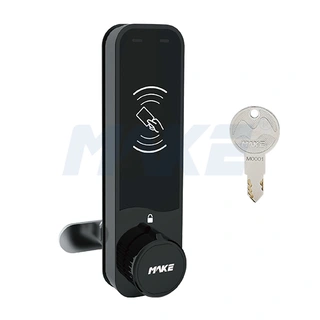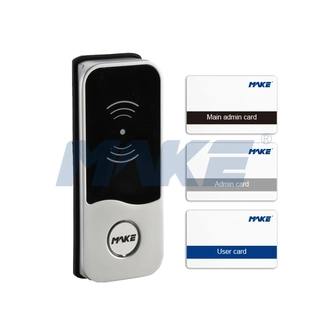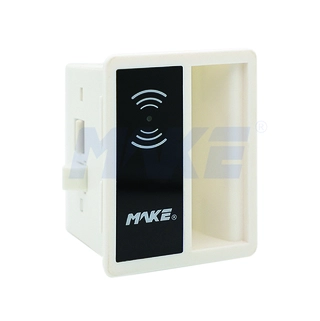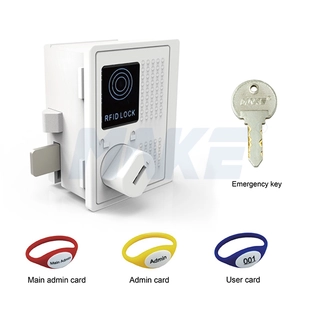4 results
An RFID lock, short for Radio Frequency Identification lock, is an advanced electronic locking system that relies on RFID technology to provide secure, keyless access control. Unlike traditional locks, an RFID lock uses radio waves to communicate wirelessly between a built-in RFID reader and a passive RFID tag or card carried by the user. When an authorized RFID tag comes within the designated range of the reader, the RFID lock system verifies the unique ID embedded in the tag and automatically activates the locking mechanism, granting access without the need for physical keys or manual entry.
These FRID locks are valued for their convenience, security, and versatility across a range of applications - from residential doors and hotel room access to commercial buildings, offices, and smart lockers. The RFID lock system is designed to support multiple levels of access permissions, easy card reprogramming, and detailed access logs, making it ideal for environments where controlled entry and user management are crucial.
As a leading RFID lock manufacturer in China, we are dedicated to producing high-quality, reliable RFID locking solutions that integrate the latest technology with robust security features. Our RFID locks are engineered for durability, ease of installation, and seamless integration with modern access management systems, helping clients enhance safety while streamlining their operations.
In an era where convenience and security must go hand in hand, RFID locks have emerged as one of the most practical and reliable solutions for access control. From modern offices and luxury hotels to residential complexes and smart homes, RFID locking systems are transforming the way people secure and manage entry to their spaces. This extensive guide explores everything you need to know about RFID locks—from how they work and their underlying technology to practical applications, key features, advantages, and common FAQs. Whether you're considering upgrading your home's security or planning a large-scale deployment in a commercial facility, this deep dive will help you make an informed choice.
Let's start with the basics: what exactly is RFID?
The RFID stands for Radio Frequency Identification, a technology that uses radio waves to wirelessly transmit information between a reader and an RFID tag, card, or label. Unlike traditional barcode systems, which require a direct line of sight to read data, RFID works on the principle of non-contact data exchange. This means the reader can capture information from the RFID tag as long as it is within its specified frequency range, without any physical contact.
An RFID system typically consists of three main components:
RFID Tag or Transponder: This contains a microchip that stores unique identification data and an antenna that transmits that data to the reader.
RFID Reader or Interrogator: The reader emits radio waves, receives signals from the tag, and passes the information to a control system.
Data Processing System: This system verifies, authenticates, and logs the interaction. For RFID locks, it decides whether to grant or deny access.
These systems can be active, passive, or semi-passive. Active RFID tags have their own power source and can transmit signals over greater distances, while passive tags rely on the electromagnetic field generated by the reader to power up and send their data. Semi-passive tags have a battery to power the microchip but communicate like passive tags.
The inherent advantage of RFID is its speed and convenience: multiple tags can be read simultaneously, and information can be updated in real time. This makes RFID ideal for a wide range of applications, from supply chain management and asset tracking to electronic payment systems and—most importantly—access control.
At their core, RFID door locks are built on the same principles as any RFID system. They use radio waves to establish a secure, wireless connection between the lock’s reader and an authorized credential, typically a card, fob, wristband, or even a smartphone with an NFC feature.
Here's a step-by-step look at what happens when you use an RFID lock:
Credential Presentation: The user brings their RFID-enabled card or fob near the lock's reader, usually within a few centimeters to a few meters, depending on the design.
Data Transmission: The reader emits an electromagnetic field that powers up the passive tag in the credential (if passive). The tag transmits its unique identification number back to the reader.
Verification: The reader sends this data to the lock's internal control system, which checks the credential against its stored database of authorized users.
Access Decision: If the ID matches, the system disengages the locking mechanism. The door unlocks, often accompanied by an audible click or LED signal. If the ID doesn't match, access is denied.
Many RFID locks also automatically relock when the door is closed, providing continuous security. Since no physical key is involved, the risks of key duplication or accidental lockouts are drastically reduced.
One of the biggest strengths of RFID locks is their versatility. You'll find them in:
Modern offices rely heavily on RFID door locks for controlling who can enter different zones. Instead of juggling multiple keys, employees can access authorized areas with a single RFID card. Access rights can be customized by department or seniority and easily updated through software. If a card is lost, it's simply deactivated—no need to change locks.
Additionally, RFID locks help with attendance tracking and accountability. Managers can generate reports to see when employees enter or exit certain areas, which can be useful for security audits and operational oversight.
Smart home enthusiasts love RFID locks for the convenience they bring. Forget the stress of hiding spare keys or fumbling with a keyring—your front door unlocks with a simple swipe or tap. Parents can issue temporary RFID tags to trusted babysitters or housekeepers and revoke access when needed. Advanced systems even work with mobile apps, so you can unlock your door with your smartphone.
RFID locks have become the gold standard in the hospitality sector. Guests receive a key card that's easy to use, difficult to duplicate, and can be instantly deactivated after checkout. For hotels, RFID locks streamline room management and reduce operational hassles associated with lost keys. The robust design—often stainless steel or extruded aluminum—ensures durability in high-traffic environments.
Hotel RFID locks often include additional features like audit trails, so management can track who entered which room and when. This enhances guest safety and helps resolve disputes or security concerns.
Lockers in schools, fitness centers, swimming pools, and spas increasingly use RFID locks. Instead of coins or padlocks, members use RFID wristbands or cards to access secure storage. This improves convenience, reduces lost keys, and allows staff to manage lockers remotely.
In factories and warehouses, RFID locks can secure supply rooms, server closets, or restricted production zones. They keep unauthorized personnel out of hazardous or confidential areas while simplifying access for authorized staff.
What makes RFID locks so appealing across all these industries? Here are some standout benefits:
RFID locks eliminate many vulnerabilities associated with traditional locks. Since there's no keyhole to pick or bump, physical lockpicking becomes virtually impossible. If a credential is lost or stolen, it can be deactivated immediately—no need to rekey locks or replace hardware.
RFID locks users no longer need to carry a jangling bunch of keys. A simple tap or swipe grants access in seconds. This is not only convenient but also more hygienic—no physical contact means fewer surfaces for germs to spread.
RFID lock system administrators can easily grant or revoke access, set time-based permissions, and manage multiple access levels. This flexibility is invaluable for growing businesses or households that frequently need to update who can enter.
Many modern RFID locks include built-in logging features. Administrators can check access records to see who entered, when, and how often. This transparency is helpful for security investigations and compliance.
RFID locks often have a sealed, contactless reader that minimizes wear and tear. Since there are fewer moving parts than in a traditional lock, maintenance needs are reduced. Weatherproof designs are available for outdoor use.
High-end RFID locks often include backup mechanical keys or PIN code entry, ensuring that you’re never locked out if the electronic system fails.
RFID locks come in various configurations to suit different needs:
Standalone Systems: Perfect for small offices, gyms, or residential use, these locks operate independently. Credentials are programmed directly into the RFID lock. No network is required.
Networked Smart Locks: Larger facilities often prefer fully networked systems that connect to a central server or cloud platform. RFID lock system allows real-time monitoring, remote access control, and integration with other security systems like CCTV or alarm systems.
For example, MAKE, a leading manufacturer of RFID locks, offers everything from basic non-networked units to advanced smart locks with centralized management. Some systems even support mobile apps, allowing administrators to unlock doors or update permissions from anywhere.
I remember chatting with a friend who runs a thriving bearings supply business. His team had grown rapidly, and managing keys became a nightmare—people lost them, made unauthorized duplicates, or forgot to return them after leaving the company.
When he switched to RFID locks, everything changed. He issued RFID cards to staff based on roles and departments. If someone left or was reassigned, he simply updated their access rights in the system—no need to physically retrieve keys or rekey locks. The RFID lock system even logs who enters which rooms and when, giving him peace of mind and better oversight of his company's confidential areas.
Imagine coming home with your hands full of groceries. Instead of struggling with keys, your door unlocks automatically when you tap your RFID card or phone. You can even issue temporary digital keys to a friend watching your pets while you're on vacation.
No more waiting in line to return keys. RFID lock cards deactivate at checkout, ensuring the next guest has a fresh card with no security risks. If a guest misplaces their card, staff can issue a new one in seconds.
In schools, RFID lockers let students store belongings safely without needing to remember padlock combinations. Administrators can open or reassign lockers remotely.
RFID locks offer an exceptional balance of security, convenience, and flexibility. They're a smart choice for offices seeking better access management, hotels wanting to elevate guest experience, or families looking to modernize their home's security. By eliminating traditional keys, you reduce risks, streamline entry, and gain better control over who can access your spaces.
When choosing an RFID lock, consider your specific needs—standalone or networked, battery life, durability, and integration with other systems. With thoughtful selection and proper management, an RFID lock system can provide peace of mind and a level of convenience that traditional locks simply can't match.
Lost RFID cards can be deactivated instantly, preventing unauthorized access. You simply get a replacement RFID lock card without changing the whole lock.
High-quality RFID locks use encryption and secure communication protocols. While older, low-end systems may be vulnerable to cloning, modern models with advanced encryption and dynamic codes are very secure.
Yes, most RFID locks run on batteries (commonly AA). Many have low-battery indicators to alert you before power runs out. Some smart locks can connect to wired power sources or backup batteries.
Absolutely—many RFID locks are weatherproof and designed to withstand rain, humidity, and extreme temperatures. Always choose a lock rated for your environment.
Yes, advanced RFID lock models can integrate with CCTV, alarms, and even home automation systems, providing a holistic security solution.




